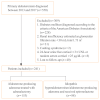Changes in Glucose Metabolism after Adrenalectomy or Treatment with a Mineralocorticoid Receptor Antagonist for Primary Aldosteronism
- PMID: 33261310
- PMCID: PMC7803597
- DOI: 10.3803/EnM.2020.797
Changes in Glucose Metabolism after Adrenalectomy or Treatment with a Mineralocorticoid Receptor Antagonist for Primary Aldosteronism
Abstract
Background: Data on the effects of excess aldosterone on glucose metabolism are inconsistent. This study compared the changes in glucose metabolism in patients with primary aldosteronism (PA) after adrenalectomy or treatment with a mineralocorticoid receptor antagonist (MRA).
Methods: Overall, 241 patients were enrolled; 153 underwent adrenalectomy and 88 received an MRA. Fasting glucose, homeostatic model assessment of insulin resistance (HOMA-IR), and homeostatic model assessment of β-cell function (HOMA-β) were compared between the treatment groups after 1 year. Plasma aldosterone concentration (PAC) and factors determining HOMA-IR and PAC were evaluated.
Results: No baseline differences were observed between the groups. Fasting insulin, HOMA-IR, and HOMA-β increased in both groups and there were no significant differences in fasting glucose following treatment. Multiple regression analysis showed associations between PAC and HOMA-IR (β=0.172, P=0.017) after treatment. Treatment with spironolactone was the only risk factor associated with PAC >30 ng/dL (odds ratio, 5.2; 95% confidence interval [CI], 2.7 to 10; P<0.001) and conferred a 2.48-fold risk of insulin resistance after 1 year compared with surgery (95% CI, 1.3 to 4.8; P=0.007).
Conclusion: Spironolactone treatment might increase insulin resistance in patients with PA. This strengthened the current recommendation that adrenalectomy is the preferred strategy for patient with positive lateralization test. Achieving a post-treatment PAC of <30 ng/dL for improved insulin sensitivity may be appropriate.
Keywords: Adrenalectomy; Hyperaldosteronism; Insulin resistance; Spironolactone.
Conflict of interest statement
No potential conflict of interest relevant to this article was reported.
Figures


Similar articles
-
A possible association between primary aldosteronism and a lower beta-cell function.J Hypertens. 2007 Oct;25(10):2125-30. doi: 10.1097/HJH.0b013e3282861fa4. J Hypertens. 2007. PMID: 17885557
-
Long-term effect of specific treatment of primary aldosteronism on carotid intima-media thickness.J Hypertens. 2015 Apr;33(4):874-82; discussion 882. doi: 10.1097/HJH.0000000000000464. J Hypertens. 2015. PMID: 25490707 Free PMC article.
-
Eplerenone improves carotid intima-media thickness (IMT) in patients with primary aldosteronism.Endocr J. 2016;63(3):249-55. doi: 10.1507/endocrj.EJ15-0362. Epub 2015 Dec 25. Endocr J. 2016. PMID: 26727302
-
Major Adverse Cardiovascular Events in Primary Aldosteronism After Adrenalectomy or Mineralocorticoid Receptor Antagonist Treatment: A Systematic Review and Meta-Analysis.J Am Heart Assoc. 2025 Feb 4;14(3):e038714. doi: 10.1161/JAHA.124.038714. Epub 2025 Feb 3. J Am Heart Assoc. 2025. PMID: 39895534 Free PMC article.
-
Progress in primary aldosteronism: mineralocorticoid receptor antagonists and management of primary aldosteronism in pregnancy.Eur J Endocrinol. 2015 Jan;172(1):R23-30. doi: 10.1530/EJE-14-0444. Epub 2014 Aug 27. Eur J Endocrinol. 2015. PMID: 25163723 Review.
Cited by
-
Recovery from diabetes mellitus in primary aldosteronism patients after adrenalectomy.BMC Endocr Disord. 2022 Dec 27;22(1):331. doi: 10.1186/s12902-022-01254-6. BMC Endocr Disord. 2022. PMID: 36572916 Free PMC article.
-
Risk of dementia in primary aldosteronism compared with essential hypertension: a nationwide cohort study.Alzheimers Res Ther. 2023 Aug 11;15(1):136. doi: 10.1186/s13195-023-01274-x. Alzheimers Res Ther. 2023. PMID: 37568223 Free PMC article.
-
[Metabolic Outcomes of Primary Aldosteronism Patients Receiving Adrenalectomy or Spironolactone Treatments].Sichuan Da Xue Xue Bao Yi Xue Ban. 2023 Nov 20;54(6):1227-1232. doi: 10.12182/20231160501. Sichuan Da Xue Xue Bao Yi Xue Ban. 2023. PMID: 38162054 Free PMC article. Chinese.
-
Serum Cystatin C Levels Could Predict Rapid Kidney Function Decline in A Community-Based Population.Biomedicines. 2022 Nov 2;10(11):2789. doi: 10.3390/biomedicines10112789. Biomedicines. 2022. PMID: 36359307 Free PMC article.
References
-
- Conn JW. Hypertension, the potassium ion and impaired carbohydrate tolerance. N Engl J Med. 1965;273:1135–43. - PubMed
-
- Menke A, Casagrande S, Geiss L, Cowie CC. Prevalence of and trends in diabetes among adults in the United States, 1988–2012. JAMA. 2015;314:1021–9. - PubMed
-
- Expert Committee on the Diagnosis and Classification of Diabetes Mellitus. Report of the expert committee on the diagnosis and classification of diabetes mellitus. Diabetes Care. 2003;26(Suppl 1):S5–20. - PubMed
-
- Kannel WB, Wilson PW, Zhang TJ. The epidemiology of impaired glucose tolerance and hypertension. Am Heart J. 1991;121(4 Pt 2):1268–73. - PubMed
-
- Fallo F, Veglio F, Bertello C, Sonino N, Della Mea P, Ermani M, et al. Prevalence and characteristics of the metabolic syndrome in primary aldosteronism. J Clin Endocrinol Metab. 2006;91:454–9. - PubMed
Publication types
MeSH terms
Substances
Grants and funding
- 101-2314-B002-085-MY3/Taiwan National Science Council/International
- 102-2314-B-002-140-MY2/Taiwan National Science Council/International
- 104-2314-B-002-125-MY3/Taiwan National Science Council/International
- 106-2314-B-002-166 -MY3 ,107-2314-B-002-026-MY3/Taiwan National Science Council/International
- PH-102-SP-09/National Health Research Institutes/International
- 106-FTN20/National Taiwan University Hospital/International
- 106-P02/National Taiwan University Hospital/International
- UN106-014/National Taiwan University Hospital/International
- 106-S3582/National Taiwan University Hospital/International
- 105-P05/National Taiwan University Hospital/International
- VN105-04/National Taiwan University Hospital/International
- 105-S3061/National Taiwan University Hospital/International
- 107-S3809/National Taiwan University Hospital/International
- 107-T02/National Taiwan University Hospital/International
- 106-2321-B-182-002/Ministry of Science and Technology, Taiwan/International
LinkOut - more resources
Full Text Sources
Medical

